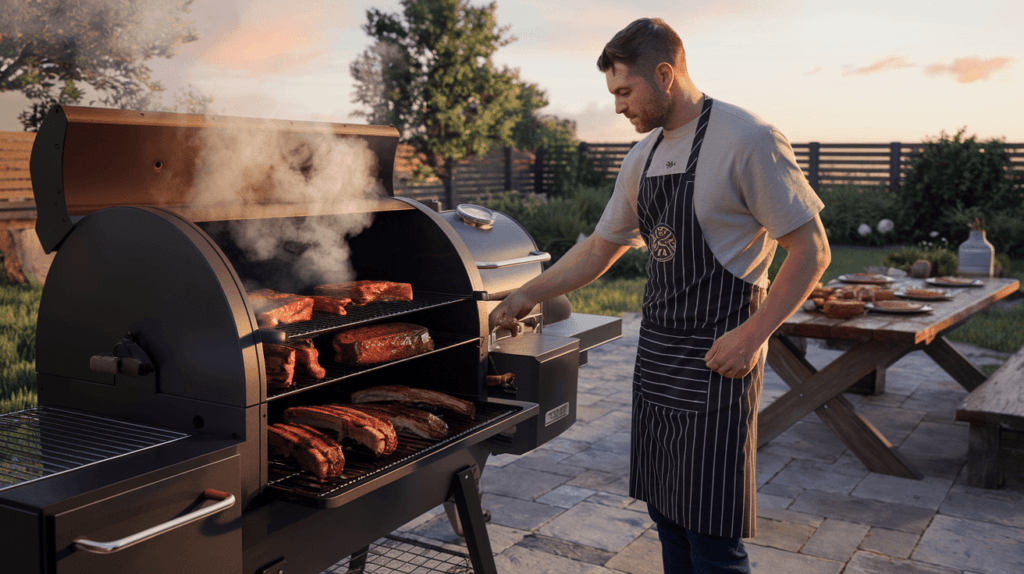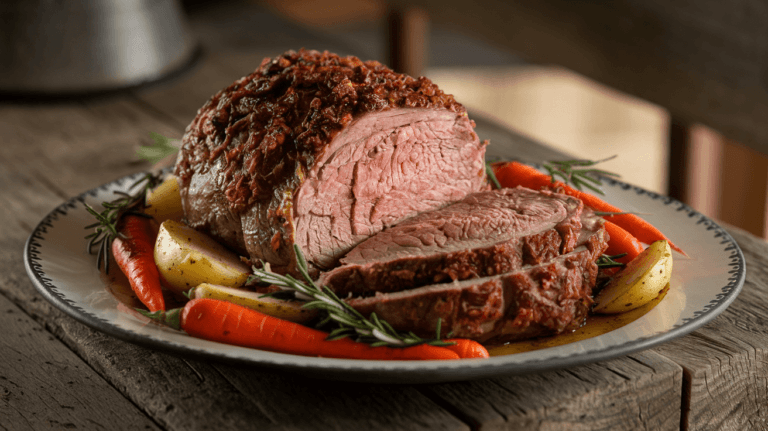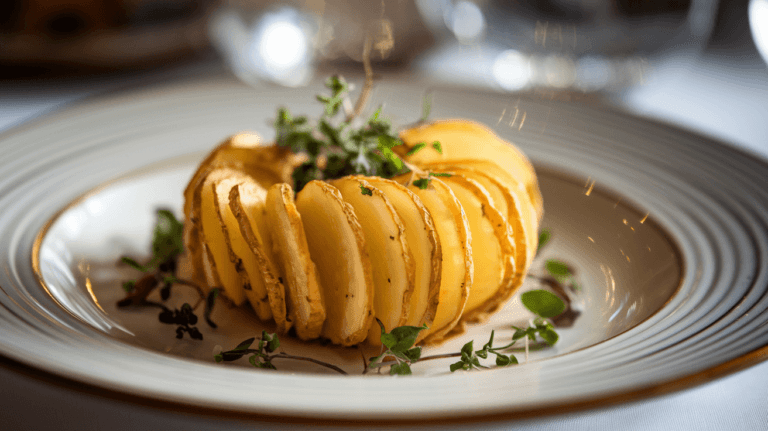Smoking food isn’t just a cooking technique it’s an art form. From juicy brisket to perfectly smoked ribs, the world of smoker recipes is packed with mouthwatering flavors and techniques that can take your BBQ game to the next level. Whether you’re a beginner or a seasoned pitmaster, this guide will help you master the essentials of smoking, from choosing the right equipment to nailing the best recipes.
Table of Contents
What is Smoking in Cooking?
Unlike grilling, which uses direct heat, smoking is a low-and-slow cooking technique that relies on indirect heat and flavored wood smoke to cook food. It typically operates at temperatures between 200°F to 275°F, allowing meats to break down gradually, resulting in tender, fall-off-the-bone goodness.
There are two main types of smoking:
- Cold smoking (below 100°F): Used for foods like cheese, nuts, and fish.
- Hot smoking (200°F+): Ideal for meats, poultry, and even vegetables.
Benefits of Using a Smoker for Cooking
Why should you choose smoking over other cooking methods? Here are some of the key benefits:
Enhanced flavor – The slow infusion of wood smoke creates a rich, deep taste you can’t get from grilling or baking.
Tender texture – Low heat breaks down tough connective tissue, making meats incredibly juicy.
Versatility – You can smoke almost anything—meats, seafood, cheese, veggies, and even desserts!
Preservation – While not as common today, smoking was originally used to extend the shelf life of food.
Different Types of Smokers: Pellet, Electric, Charcoal, and Gas
Not all smokers are created equal! Choosing the right one depends on your cooking style and preference.
Pellet Smokers – These are easy to use, with automatic temperature control and wood pellets for authentic smoke flavor. Perfect for beginners!
Electric Smokers – Great for set-it-and-forget-it convenience. Just plug it in, add wood chips, and let it do its thing.
Charcoal Smokers – The classic choice for those who love an authentic, deep smoky taste. They require more effort but deliver unmatched flavor.
Gas Smokers – Propane-powered, offering consistent heat with minimal effort. Ideal for those who want ease without sacrificing flavor.
Ingredients for Smoker Recipes
Must-Have Tools for Smoking Meat and Vegetables
To make the best smoker recipes, you need the right equipment. Whether you’re a beginner or a pitmaster, these tools will help you achieve that perfect smoky flavor:
- A quality smoker – Whether it’s a pellet smoker, electric smoker, or charcoal smoker, choosing the right one is key.
- Meat thermometer – Ensures your meat is cooked to the perfect temperature without overcooking.
- Wood chips or pellets – Choose the right type based on the flavor profile you want (more on this below!).
- Drip pan – Helps catch excess grease and prevents flare-ups.
- Water pan – Maintains moisture inside the smoker, preventing dry meat.
- Grill tongs & heat-resistant gloves – Keep your hands safe while handling hot meat and smoker parts.
Best Types of Wood for Smoking: Hickory, Mesquite, Applewood, and More
The type of wood you use can make or break your dish. Here are the most popular options:
- Hickory – A classic choice, perfect for brisket, ribs, and pork shoulder. It delivers a strong, smoky flavor.
- Mesquite – A bold, earthy wood ideal for beef and game meats but should be used sparingly.
- Applewood – A milder, slightly sweet option that works well with pork, chicken, and seafood.
- Cherrywood – A balanced wood that adds a subtle fruitiness, great for poultry and pork.
- Oak – A neutral, versatile choice that pairs well with almost any meat.
Essential Seasonings and Marinades for Smoker Recipes
A great smoker recipe starts with a flavorful rub or marinade. Here’s what you need:
- Dry rubs – A mix of salt, pepper, paprika, garlic powder, onion powder, and brown sugar enhances the natural flavor of meats.
- Marinades – Combine acidic ingredients like vinegar or citrus juice with seasonings to tenderize and add flavor.
- Glazes & sauces – Brushing your meat with BBQ sauce or honey glaze in the final stage adds an extra layer of deliciousness.
Now that you have the tools and ingredients, let’s move on to some beginner-friendly smoker recipes in Part 3!
Best Smoker Recipes for Beginners

Smoked Pork Butt: A Step-by-Step Guide
One of the easiest smoker recipes to start with is smoked pork butt. It’s forgiving, packed with flavor, and perfect for making pulled pork.
Instructions:
- Prepare the pork butt – Trim excess fat, leaving about ¼ inch for moisture.
- Apply the rub – Coat generously with a dry rub of paprika, salt, pepper, garlic powder, and brown sugar.
- Preheat the smoker – Set it to 225°F and use hickory or applewood for optimal flavor.
- Smoke low and slow – Cook for 8-10 hours until the internal temperature reaches 195°F-205°F.
- Rest and shred – Let it rest for 30 minutes before shredding with forks.
Smoked Whole Chicken: Simple and Flavorful
Chicken is a fantastic option for beginners because it cooks faster and absorbs smoke well.
Instructions:
- Brine the chicken – Soak in salt water overnight to keep it juicy.
- Season the bird – Apply a mix of butter, garlic powder, smoked paprika, and rosemary under the skin.
- Smoke at 275°F – Use applewood or cherrywood for a mild, sweet flavor.
- Cook until 165°F – This usually takes 3-4 hours, depending on the size of the bird.
Smoked Baby Back Ribs: The 3-2-1 Method Explained
If you want fall-off-the-bone ribs, the 3-2-1 method is the way to go!
Instructions:
- Prep the ribs – Remove the membrane and coat with a brown sugar, salt, and cayenne rub.
- Smoke for 3 hours – At 225°F using hickory or mesquite wood.
- Wrap and cook for 2 hours – Wrap ribs in foil with apple juice and let them steam.
- Unwrap and glaze – Brush with BBQ sauce and cook for 1 more hour.
Classic Smoked Meats: Beef, Pork, and Poultry
When it comes to smoker recipes, the classics never fail. These meats are the stars of BBQ, delivering juicy, smoky flavors that leave everyone wanting more. Whether you’re craving brisket, pulled pork, or chicken wings, this section covers the must-try classics.
How to Make Perfect Smoked Brisket
Smoking brisket is a true test of patience—but the results are unbeatable.
Instructions:
- Trim the brisket – Leave a thin fat layer to keep it moist.
- Season generously – Use a salt, black pepper, and garlic powder rub.
- Preheat the smoker – Set to 225°F, using oak or hickory wood.
- Smoke low and slow – Cook until the internal temperature reaches 165°F (about 6-8 hours).
- Wrap and finish cooking – Wrap in butcher paper and continue smoking until 200°F-205°F (another 4-6 hours).
- Rest before slicing – Let it rest for 1 hour for juicy, tender slices
Smoked Pulled Pork: Low and Slow for Tender Perfection
Pulled pork is one of the most satisfying smoker recipes, perfect for sandwiches, tacos, or just eating straight from the plate.
Instructions:
- Choose the right cut – Pork shoulder or Boston butt works best.
- Season with a rub – Use a mix of paprika, salt, sugar, and garlic powder.
- Smoke at 225°F – Use hickory or applewood and cook for 10-12 hours.
- Wrap and finish – Wrap in foil when it reaches 165°F, then continue until 195°F-205°F.
- Shred and serve – Let it rest, then pull apart with forks.
Smoked Chicken Wings with Dry Rub vs. Sauce
Chicken wings are a quick and easy option for smoking, perfect for game days or casual BBQs.
Instructions:
- Pat dry and season – Coat with a rub of garlic powder, smoked paprika, salt, and cayenne.
- Smoke at 250°F – Use cherrywood for a hint of sweetness.
- Crisp them up – Increase heat to 375°F in the last 10 minutes.
- Sauce or dry rub? – Toss in BBQ sauce or enjoy them as-is with extra rub.
Unique and Unexpected Smoker Recipes

While classic meats are great, there’s a whole world of unique smoker recipes beyond beef and pork. Try these unexpected smoked dishes for a fun twist on BBQ.
Smoked Macaroni and Cheese: A Creamy, Smoky Delight
Yes, you can smoke mac and cheese and it’s mind-blowingly good!
Instructions:
- Cook pasta – Boil until just al dente.
- Make a cheese sauce – Combine cheddar, gouda, milk, and butter.
- Assemble and smoke – Mix pasta with sauce, top with breadcrumbs, and smoke at 225°F for 1 hour.
Smoked Shrimp with Garlic Butter: Seafood on the Smoker
Seafood might not be the first thing that comes to mind for smoking, but trust us—shrimp absorbs that smoky flavor beautifully.
Instructions:
- Season the shrimp – Toss with olive oil, garlic, lemon, and Old Bay seasoning.
- Smoke at 225°F – Use applewood for a mild, sweet touch.
- Cook for 30 minutes – Shrimp cook fast, so keep an eye on them!
Smoked Sweet Potatoes: A Perfect Side Dish
Smoked sweet potatoes take on a deep, caramelized flavor, making them an excellent side dish.
Instructions:
- Prep the potatoes – Scrub clean, then pierce with a fork.
- Season lightly – Rub with olive oil, cinnamon, and sea salt.
- Smoke at 250°F – Cook for about 2 hours, until tender.
Smoked Whiskey Wings: A Flavorful Twist
These wings get an extra kick from a whiskey-infused sauce!
Instructions:
- Season the wings – Use smoked paprika, brown sugar, and black pepper.
- Smoke at 250°F – Cook for about 90 minutes, then crisp at 375°F.
- Glaze with whiskey sauce – Mix whiskey, honey, and BBQ sauce, then brush over the wings.
Let the sauce caramelize on the wings for maximum flavor!
For more delicious recipes, check out this smoky chili recipe on Tasty Meal Diary. It’s a perfect addition to any BBQ feast!
Vegetarian and Vegan Smoker Recipes
Think smoking is only for meat lovers? Think again! Many vegetarian and vegan smoker recipes offer that same rich, smoky depth of flavor, turning simple plant-based ingredients into irresistible dishes. Whether you’re a full-time vegan or just looking to add variety to your BBQ lineup, these smoky plant-based dishes will impress everyone at the table.
Smoked Tofu: A Protein-Packed Option
Tofu is like a sponge it soaks up flavors beautifully, making it a fantastic choice for smoking.
Instructions:
- Press the tofu – Remove excess moisture using a tofu press or paper towels.
- Marinate for maximum flavor – Use a mix of soy sauce, garlic, smoked paprika, and maple syrup. Let it sit for at least an hour.
- Smoke at 225°F – Use applewood or cherrywood for a subtle sweetness. Smoke for about 1.5 hours.
- Crisp it up (optional) – Finish on a hot grill for a crispy outer layer.
Smoked Portobello Mushrooms: A Meat-Lover’s Favorite
Portobello mushrooms have a deep, meaty texture, making them a great alternative to smoked meats.
Instructions:
- Clean and season the mushrooms – Remove stems and gills, then brush with olive oil, balsamic vinegar, and garlic powder.
- Smoke at 225°F – Use hickory or oak wood for a bold, earthy flavor. Smoke for 60-90 minutes.
- Serve as a burger or side dish – These mushrooms make an amazing base for a vegan BBQ sandwich!
Smoked Vegetables: Zucchini, Peppers, and More
Vegetables take on an incredible depth of flavor when smoked. Try zucchini, bell peppers, carrots, or even cauliflower for a tasty side dish.
Instructions:
- Season simply – Toss veggies in olive oil, salt, pepper, and a pinch of smoked paprika.
- Smoke at 225°F – Use pecan or applewood for a mild, sweet touch.
- Cook until tender – Most veggies take about 45 minutes to 1 hour.
For a smoky char, finish them on the grill for a few minutes!
Tips and Tricks for the Best Smoker Recipes
Smoking food isn’t just about tossing ingredients in and hoping for the best. To truly master smoker recipes, follow these essential tips and tricks for foolproof results every time.
Temperature Control and Ideal Cooking Times
Maintaining the right temperature is key to achieving perfectly smoked dishes.
Low and slow wins the race – Most smoked meats cook best between 200°F-275°F.
Use a reliable thermometer – Never guess! A meat probe ensures your food is cooked to the right temperature.
Keep the lid closed – Opening the smoker too often lets heat and smoke escape, which can disrupt cooking.
Different meats require different smoking times. A brisket can take 12-14 hours, while chicken wings may be done in 90 minutes.
How to Prevent Dry Meat When Smoking
One common mistake in smoking is ending up with dry, tough meat. Avoid this by:
Using a water pan – This keeps humidity levels high and prevents meats from drying out.
Spritzing with apple juice or broth – Lightly spray every hour for extra moisture.
Wrapping meats in foil or butcher paper – This helps retain juices once the meat reaches around 165°F.
The Best Wood Pairings for Different Proteins
Not all woods are created equal! Choose the right one for the best flavor.
- Beef: Oak, hickory, mesquite – Bold flavors that complement rich meats.
- Pork: Applewood, cherry, pecan – Slightly sweet, enhancing the natural flavors.
- Chicken: Applewood, maple, hickory – Adds depth without overpowering.
- Seafood: Alder, applewood, cherry – Light, delicate smoke enhances seafood.
Mix different wood types to create unique flavor combinations!
FAQs
Smoking food is a craft, and like any skill, it comes with plenty of questions. Whether you’re just starting or looking to refine your techniques, these frequently asked questions about smoker recipes will help you smoke like a pro.
What is the best meat to smoke for beginners?
If you’re new to smoking, start with forgiving cuts of meat that stay juicy even if slightly overcooked. Here are some great beginner-friendly choices:
Pork butt (pork shoulder): Easy to smoke and packed with flavor.
Chicken thighs or whole chicken: Less expensive and full of moisture.
Beef brisket (if you’re patient!): While more challenging, it’s worth the effort.
Stick to a low and slow cooking method around 225°F-250°F for the best results.
Can you use a smoker in cold weather?
Absolutely! However, smoking in colder temperatures requires a few adjustments:
Use a well-insulated smoker – Pellet and electric smokers with insulation work best in the cold.
Monitor fuel consumption – Charcoal and wood burn faster in the cold, so check levels often.
Block the wind – Wind can mess with temperature control, so position your smoker in a sheltered area.
How long should you let meat rest after smoking?
Resting is crucial for locking in juices and enhancing flavor.
Brisket & pork butt: Rest for 1 hour (wrapped in butcher paper or foil).
Chicken & ribs: Rest for 15-30 minutes to retain moisture.
What are the best wood chips for smoking beef, pork, and chicken?
Choosing the right wood can make or break your smoker recipes. Here’s a quick guide:
Beef: Oak, mesquite, or hickory for a bold, rich taste.
Pork: Applewood, cherry, or pecan for a slightly sweet, smoky flavor.
Chicken: Maple, hickory, or fruit woods like cherry for a balanced taste.
Top 10 Smoker Recipes

Here are the top 10 smoker recipes from our guide, ranked based on their incredible flavor, ease of preparation, and overall popularity. Whether you’re a BBQ beginner or a seasoned pitmaster, these recipes will elevate your smoking game!
1. Smoked Brisket
A BBQ classic! Slow-smoked for up to 14 hours, this brisket develops a perfect smoke ring and juicy, tender slices. Best paired with hickory or oak wood.
2. Smoked Pulled Pork
A flavorful and forgiving cut, pork shoulder (or Boston butt) is smoked low and slow until it shreds effortlessly. Hickory or applewood enhances the taste.
3. Smoked Baby Back Ribs (3-2-1 Method)
This foolproof method delivers fall-off-the-bone ribs with a rich glaze. The combination of smoke, foil wrapping, and a final glaze layer makes them irresistible.
4. Smoked Whole Chicken
Crispy skin, juicy meat, and an infusion of smoky goodness make this one of the easiest and tastiest smoker recipes. Applewood or cherrywood works best.
5. Smoked Mac and Cheese
A comfort food favorite with a smoky twist! Cooked in a cast-iron skillet and infused with hickory or pecan wood, this dish is rich, creamy, and delicious.
6. Smoked Whiskey Wings
These wings get an extra flavor boost from a whiskey-infused glaze. Perfectly crispy and smoky, they’re best cooked with hickory or maple wood.
7. Smoked Sweet Potatoes
A smoky spin on a healthy side dish, these sweet potatoes develop a caramelized texture when smoked over pecan or applewood.
8. Smoked Portobello Mushrooms
A vegetarian favorite! Portobello mushrooms absorb smoke beautifully and have a meaty texture, making them a fantastic plant-based BBQ option.
9. Smoked Tofu
Perfect for vegans and vegetarians, smoked tofu soaks up applewood or cherrywood smoke, creating a deliciously smoky, firm texture.
10. Smoked Shrimp with Garlic Butter
Quick and flavorful! These smoky, garlicky shrimp are ready in just 30 minutes, making them a fantastic appetizer or main dish.
Conclusion
Mastering smoker recipes takes time, patience, and the right techniques. From choosing the best smoker and wood types to nailing the right temperatures and seasonings, every step plays a role in crafting the perfect smoked dish.
Here’s a quick recap of the key takeaways from this guide:
Start with the right smoker – Choose between pellet, electric, charcoal, or gas based on your preference.
Select quality wood – Match woods like hickory, applewood, and mesquite to your meats.
Master the cooking process – Use low and slow temperatures and keep a water pan for moisture.
Experiment with flavors – Try different rubs, marinades, and sauces to customize your BBQ.
If you’re looking for more tasty recipes, check out our collection of delicious meal ideas!




